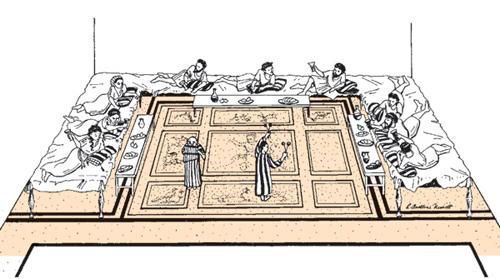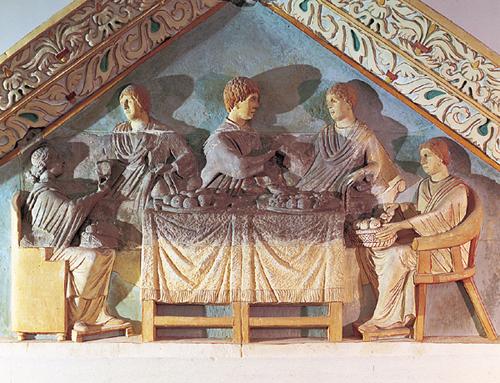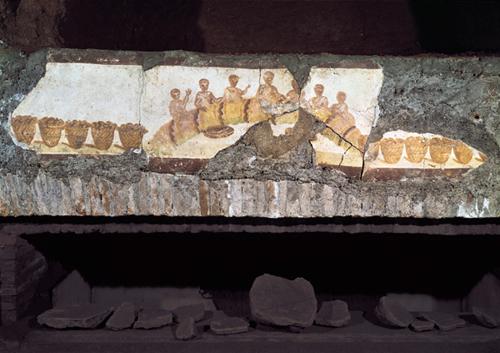PART.2
As in the Israelite monarchy, Greco-Roman feasts functioned as important social and political tools. Scholar Dennis E. Smith noted that “meals were a means of creating and solidifying social bonds.”8 Where a person was positioned at a banquet made it quite clear where he fell in the pecking order among the attendees. The place of honor was immediately to the right of the host and then continued around the table in decreasing order, leaving the lowest guest at the far end. It was not uncommon for the lower guests to receive different (i.e., lower quality) food from what was being served to the host and honored guests.

Reconstruction of a banquet in a typical triclinium, based on a mosaic floor design from a Roman villa. Ancient diners reclined on their left elbows and ate with their right hands. Drawing by Romney Oualline Nesbitt/©Romney Oualline Nesbitt and Dennis E. Smith.
Understanding this social order and dining structure is important for properly interpreting several passages in the New Testament. Jesus often used the meal setting as a teaching opportunity. Rather than dining only with the elite, he shared his meals with sinners, tax collectors and other social outcasts (Matthew 9:10; Mark 2:15; Luke 5:29).9 Instead of letting the lowest guest at a meal serve the others, he set an example of service by washing his disciples’ feet (John 13:1–17).10 He taught them humility by telling them always to take the lowest place at a table, rather than endure the potential shame of being displaced by a higher-ranking guest (Luke 14:7–10). The Gospel of John says that at the Last Supper the beloved disciple was reclining in the bosom of Jesus, which means that he was seated next to him in the position of honor (John 13:23). The fact that Judas was close enough to accept a piece of bread “dipped in the dish” from Jesus suggests that he, too, may have been reclining nearby. And of course commemoration of this Last Supper developed into the Eucharist—an important ritual and communal meal for all Christians.
Community meals were also an important teaching tool for Paul—especially with the first Christians at Corinth. Ritual feasts of sacrificial meat offered to the gods at pagan temples were an extremely common occurrence in Corinth, but they posed a conflict of interest for some of these early Christians.11 For Paul, the problem was not really the consumption of idol meat per se (because “we know that ‘an idol has no real existence,’” 1 Corinthians 8:4), but rather the effect that such temple feasts could have on the Christian community. Meals were all about whom you socialized with, so rather than associating with the drunkenness and debauchery of the usual Greco-Roman feasts, and potentially causing a fellow believer to “stumble” (1 Corinthians 8:9–13), Paul preferred private meals shared in common with other Christians—to help build and strengthen the community.

In this first-century painted marble tomb carving from Trier, Germany, formally dressed diners lie on a couch and sit on chairs around a table with a meal of cakes, fruit and wine. These scenes likely depict past meals with the deceased. Erich Lessing.
The early Christians also combined another traditional Greco-Roman meal, the funerary banquet, with their own interpretation of the Jewish messianic banquet.12 Roman tombs and sarcophagi depict scenes of the deceased feasting with this family. It was also common for family members and friends to hold a banquet in honor of the deceased in special dining rooms constructed nearby for these memorial meals (called refrigeria in Latin). Christian burials in Roman catacombs show evidence of this practice as well, but for them it meant something more than simply remembering the deceased.

Seven young men are pictured enjoying a lively repast in frescoes from burial chambers in the Catacomb of Callistus in Rome. The third-century catacomb contains some of the earliest known Christian art, including several similar paintings of banquets meant to represent the afterlife. Scala/Art Resource, NY.
Jesus recalled the tradition of the messianic banquet at the Last Supper: “I tell you that I shall not drink again of this fruit of the vine until that day when I drink of it new with you in my Father’s kingdom” (Matthew 26:29). Dennis Smith sees another connection in the story of the rich man and Lazarus (Luke 16:19–21): “The poor man, who once longed for a crumb from the rich man’s table, is now ’in the bosom of Abraham’ (Luke 16:23), that is to say, reclining just to the right of Abraham himself, in a position of honor, at the banquet of the afterlife.”13 Paintings on the walls of the catacombs depict this heavenly banquet and represent a wish for the deceased to enjoy a sumptuous feast in the society of all the blessed in paradise.14
Notes
1. See Dominic Rudman, “When Gods Go Hungry,” Bible Review, June 2002.
2. See Nathan MacDonald, Not Bread Alone: The Uses of Food in the Old Testament (Oxford: Oxford Univ. Press, 2008) p. 157. MacDonald, p. 203.
3. See Bruce Chilton, “The Eucharist—Exploring Its Origins,” Bible Review, December 1994.
4. See Dennis E. Smith, “Dinner with Jesus & Paul,” Bible Review, August 2004.
5. See Baruch M. Bokser, “Was the Last Supper a Passover Seder?” Bible Review, Spring 1987.
6. See Dennis E. Smith, “Dinner with Jesus & Paul,” Bible Review, August 2004.
7. See Dennis E. Smith, “Dinner with Jesus & Paul,” Bible Review, August 2004.
8. See Bruce Chilton, “The Eucharist—Exploring Its Origins,” Bible Review, December 1994.
9. See Dennis E. Smith, “Dinner with Jesus & Paul,” Bible Review, August 2004.
10. See Ben Witherington, “Why Not Idol Meat?” Bible Review, June 1994.
11. See Robin A. Jensen, “Dining in Heaven,” Bible Review, October 1998.
12. See also “The Death of Midas: An Eternal Feast,” Archaeology Odyssey, November/December 2001.
13. See Dennis E. Smith, “Dinner with Jesus & Paul,” Bible Review, August 2004.
14. See Robin A. Jensen, “Dining in Heaven,” Bible Review, October 1998.